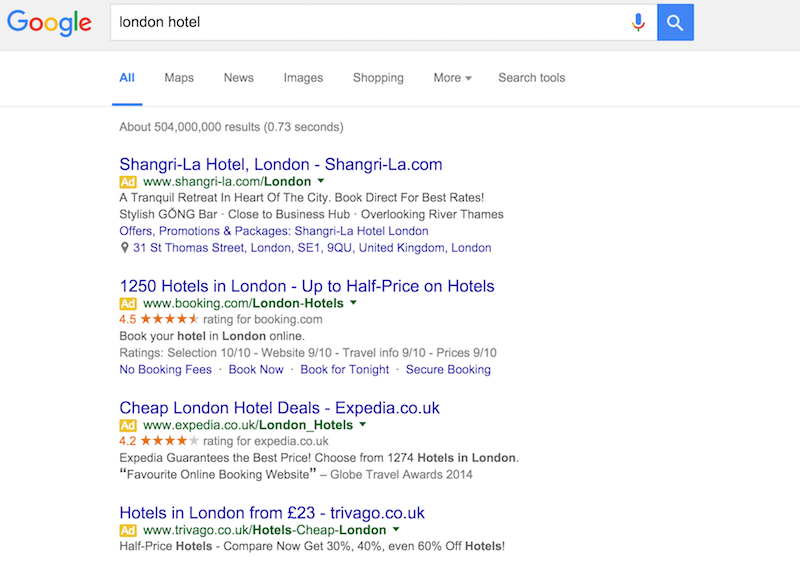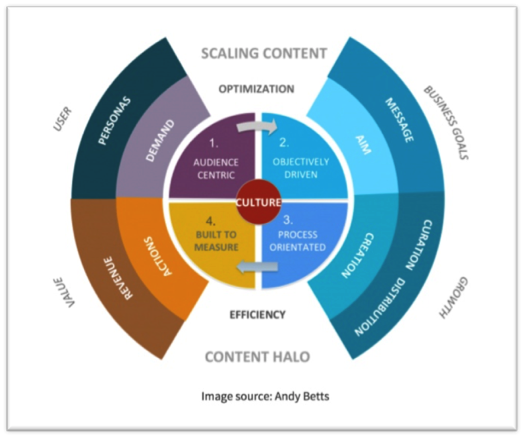Recent changes made to the Google SERP have taken many by surprise.
Google has eliminated the sidebar ads that once appeared to the right of the results. They have also increased the number of ads allowed above the results, now showing up to four ads.
This has marketers talking because, with four sponsored results, there are fewer slots available for organic results above the fold. Some queries might not have any organic results appear without the user having to scroll down.
One of the main questions on everyone’s mind, is how these changes are going to affect paid and organic search…
What marketers need to know
The impact of the new layout on organic search will come from two main sources: changes in marketing strategy and the layout itself.
First, we must explore how the changes are impacting PPC marketing.
Although the new layout has increased the number of ads that appear at the top of the SERP for most queries, the removal of the sidebar ads means that there will still be less ads overall on the page.
The ads that are along the top of the page have been designed by Google to be more natural (more native) looking. Given the increased competition for these more coveted ad spots, it is likely that the new layout will drive up prices for paid ads.
The increase in price and competition may then force some brands, particularly those with smaller marketing budgets, to shift gears.
Some will begin to focus on lower cost keywords and others will turn their focus more towards organic search performance optimization. This may result in more brands paying attention to their organic search results.
The content marketing industry has already seen an increasingly competitive playing field as brands have begun to pay attention to the success that others are having. This will only increase the amount of competition, and therefore the necessity to ensure organic and content strategies are built for maximum performance.
How marketers can make their content stand out
Making your content stand out in the new SERP means taking a comprehensive view of your customers and your content.
You’ll want to think of your entire brand reputation. Your content will see organic search success when you are the brand that customers already trust when they type in a query.
Reaching this point means producing high-quality content that answers the needs of customers. Brands need to write what their customers find interesting.
This starts by identifying what topics are in demand. Produce a variety of types of content, including videos, articles and infographics, to address the questions of these users.
Track your success with each piece of content, watching engagement rates and conversion rates, and see the types of content that are best serving the needs of customers at each stage of the customer journey.
In addition to producing the content that people will appreciate, you will also need to take the time to develop a strong social media presence. This will provide you with multiple opportunities:
- you can interact directly with your potential customers through the social media platforms
- you can answer people’s questions, helping to establish yourself as an authority
- you can share and promote your content, growing your audience
- as you attract more attention to your content, you will help to raise the ranking through backlinks, traffic rates and engagement. This is how content, search and social work together
Your comprehensive outlook also needs to stretch beyond what you put online. Providing customers with an outstanding experience can help you improve your reputation and bring new customers to your door.
With the popularity of review sites like Yelp, customers can easily learn about the most popular and least popular companies. An excellent customer experience will help you improve your reputation through these sites and word-of-mouth.
Local and Places
You also need to make sure that your content is completely optimized. Now that ads are so prominently featured in the SERPs, you need to make sure that your results can compete with them aesthetically.
Ads are likely to become increasingly visual and engaging as the industry continues to evolve, and you need to make sure you use all your available resources to remain relevant.
This means using meta tags and schema when possible so that your website is accurately represented and that any opportunities for rich snippets are seized.
Optimization also means looking at your available options from all angles. For example, local optimization might not be the first priority for a business that does the majority of their business online, but if you have an actual location, it can be a valuable resource. Our BrightEdge research has indicated that this optimization can help you improve your traffic by 21 percent.
Five steps to succeeding on the new Google SERP
- Use data to identify highly desirable content and develop material that provides the user with what they need. Remember to create a variety of different types of content and regularly track customer reactions to see what people respond to best at different points in the buyer’s journey.
- Do not neglect optimizing for Local and Places.
- Use the content, search and social trifecta to promote your content, attract attention and improve quality metrics, such as engagement rates and backlinks. While on social media, actively engage with your audience so that you improve your reputation as a trusted authority.
- Make sure the content is marked up with meta tags and schema so that you can attract as much attention to it as possible. It is likely that ads are going to continue to evolve and become more visually appealing, so make sure that your content answers the same need.
- Measure your results and make adjustments as necessary. Monitor your rank position, your click-through rate and engagement rates to see how this SERP change has impacted your success.
There are benefits and drawbacks to the new Google SERP layout, for marketers, the primary priority should be learning how to succeed in the new system.
Keep in mind the importance of a positive customer experience with every interaction with your brand while also optimizing your content to maximize your appeal against the ad results. Working smarter and creating comprehensive search and content strategies will improve performance.
The article How to compete on the new Google SERP was first seen from https://searchenginewatch.com


No comments:
Post a Comment